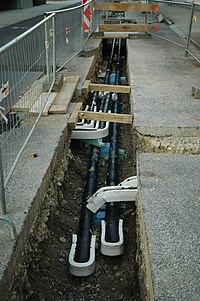Insulated pipe

An insulated pipe is like wrapping a warm blanket around a long straw. You know how sometimes you drink cold things through a straw and your hand gets all cold and shivery? Well, the same thing can happen to the liquids or gases that travel though pipes. That's where the insulated pipe comes in!
First, let's talk about what insulation means. You know how you wear a coat when it's really cold outside? That coat keeps you warm because it traps your body heat, right? Well, insulation is like a special coat for pipes. It keeps things that are supposed to be hot (like hot water or steam) hot, and things that are supposed to be cold (like refrigerant) cold.
Insulation can come in many different forms, but for pipes, the most common type is made of fiberglass or foam. These materials are soft and squishy, like a big marshmallow. They come in long, skinny pieces that are wrapped around the pipe like a giant spiral.
The insulation layer helps to slow down the transfer of heat or cold through the pipe walls. Think of it like this: if you're outside on a hot day and you touch a metal fence, it feels really hot because metal conducts heat really well. But if you touch a fence with a layer of foam or fiberglass padding on it, it won't feel as hot because the insulation slows down the heat transfer.
Insulated pipes are used in all sorts of industrial and residential settings. They can be found in factories, power plants, and even in your house! The pipes that carry hot water from your water heater to your faucets are often insulated to keep the water hot and save energy.
So, next time you see a big pipe with a squishy layer around it, remember that it's like a warm blanket for the liquid or gas that's traveling inside.
First, let's talk about what insulation means. You know how you wear a coat when it's really cold outside? That coat keeps you warm because it traps your body heat, right? Well, insulation is like a special coat for pipes. It keeps things that are supposed to be hot (like hot water or steam) hot, and things that are supposed to be cold (like refrigerant) cold.
Insulation can come in many different forms, but for pipes, the most common type is made of fiberglass or foam. These materials are soft and squishy, like a big marshmallow. They come in long, skinny pieces that are wrapped around the pipe like a giant spiral.
The insulation layer helps to slow down the transfer of heat or cold through the pipe walls. Think of it like this: if you're outside on a hot day and you touch a metal fence, it feels really hot because metal conducts heat really well. But if you touch a fence with a layer of foam or fiberglass padding on it, it won't feel as hot because the insulation slows down the heat transfer.
Insulated pipes are used in all sorts of industrial and residential settings. They can be found in factories, power plants, and even in your house! The pipes that carry hot water from your water heater to your faucets are often insulated to keep the water hot and save energy.
So, next time you see a big pipe with a squishy layer around it, remember that it's like a warm blanket for the liquid or gas that's traveling inside.
Related topics others have asked about:
